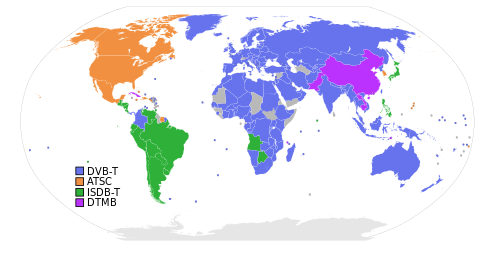This article needs additional citations for verification .(May 2010) |

| List of digital television broadcast standards |
|---|
| DVB standards (countries) |
| ATSC standards (countries) |
|
| ISDB standards (countries) |
| DTMB standards (countries) |
| DMB standard (countries) |
| Codecs |
|
| Terrestrial Frequency bands |
| Satellite Frequency bands |
Digital television (DTV) is the transmission of television signals using digital encoding, in contrast to the earlier analog television technology which used analog signals. In the 2000s [1] it was represented as the first significant evolution in television technology since color television in the 1950s. [2] Modern digital television is transmitted in high-definition television (HDTV) with greater resolution than analog TV. It typically uses a widescreen aspect ratio (commonly 16:9) in contrast to the narrower format (4:3) of analog TV. It makes more economical use of scarce radio spectrum space; it can transmit up to seven channels in the same bandwidth as a single analog channel, [3] and provides many new features that analog television cannot. A transition from analog to digital broadcasting began around 2000. Different digital television broadcasting standards have been adopted in different parts of the world; below are the more widely used standards:
Contents
- History
- Background
- Development
- Inaugural launches
- Technical information
- Formats and bandwidth
- Reception
- Protection parameters
- Interaction
- Comparison to analog
- Compression artifacts, picture quality monitoring and allocated bandwidth
- Effects of poor reception
- Effect on old analog technology
- Disappearance of TV-audio receivers
- Environmental issues
- See also
- References
- Further reading
- External links
- Digital Video Broadcasting (DVB) uses coded orthogonal frequency-division multiplexing (OFDM) modulation and supports hierarchical transmission. This standard has been adopted in Europe, Africa, Asia and Australia, for a total of approximately 60 countries.
- Advanced Television System Committee (ATSC) standard uses eight-level vestigial sideband (8VSB) for terrestrial broadcasting. This standard has been adopted by 9 countries: the United States, Canada, Mexico, South Korea, Bahamas, Jamaica, the Dominican Republic, Haiti and Suriname.[ citation needed ]
- Integrated Services Digital Broadcasting (ISDB) is a system designed to provide good reception to fixed receivers and also portable or mobile receivers utilizing OFDM and two-dimensional interleaving. It supports hierarchical transmission of up to three layers and uses MPEG-2 video and Advanced Audio Coding. This standard has been adopted in Japan and the Philippines. ISDB-T International is an adaptation of this standard using H.264/MPEG-4 AVC, which has been adopted in most of South America as well as Botswana and Angola. 1seg (1-segment) is a special form of ISDB. Each channel is further divided into 13 segments. Twelve are allocated for HDTV and the other for narrow-band receivers such as mobile televisions and cell phones.
- Digital Terrestrial Multimedia Broadcast (DTMB) adopts time-domain synchronous (TDS) OFDM technology with a pseudo-random signal frame to serve as the guard interval (GI) of the OFDM block and the training symbol. The DTMB standard has been adopted in China, including Hong Kong and Macau. [4]
- Digital Multimedia Broadcasting (DMB) is a digital radio transmission technology developed and adopted in South Korea [5] [6] [7] as part of the national information technology project for sending multimedia such as TV, radio and datacasting to mobile devices such as mobile phones, laptops and GPS navigation systems.
